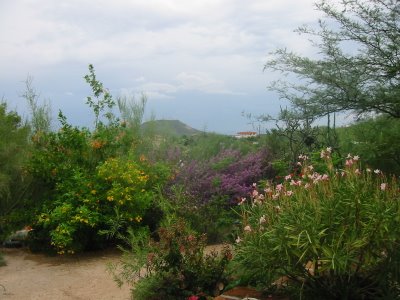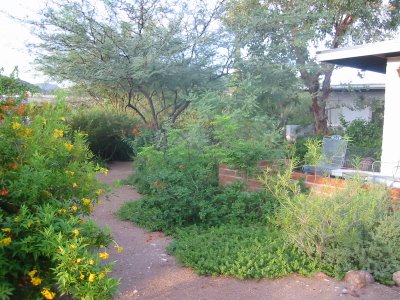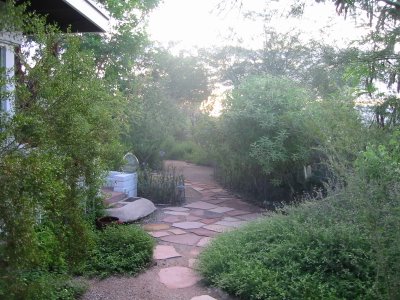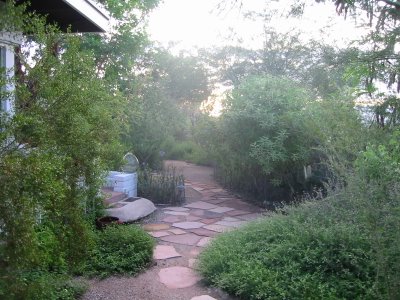






How an amateur gardener created a small garden that thrives in Tucson, Arizona's desert climate.

 Here are two of my beds one year later. The chicken wire was attached to rebar and wood stakes to keep the rabbits out. Note that there are rubber protectors on top of the rebar to protect against someone falling on one and impalling themselves. Not much you can do about Javalina as they can jump easily over the fence. My mixture of dirt to compost is one to three (one part compost, two part dirt). The mesquites came from 5 gallon pots and were placed in holes twice as deep as the 18"bed. Plants used included salvia leucantha, salvia greggi, ruelia, mexican sunflower, casia and mexican primrose and many other desert varieties. Desert Survivors Nursery on West 22nd St. near A Mountain is wonderful place to purchase plants. They grow their plants on site, a big plus since your plant will have had plenty of time to acclimate to Tucson's climate. I also recommend using rocks and boulders in your beds. They give your garden texture and provide a natural setting for plants. Boulders also shelter roots from the hot sun.
Here are two of my beds one year later. The chicken wire was attached to rebar and wood stakes to keep the rabbits out. Note that there are rubber protectors on top of the rebar to protect against someone falling on one and impalling themselves. Not much you can do about Javalina as they can jump easily over the fence. My mixture of dirt to compost is one to three (one part compost, two part dirt). The mesquites came from 5 gallon pots and were placed in holes twice as deep as the 18"bed. Plants used included salvia leucantha, salvia greggi, ruelia, mexican sunflower, casia and mexican primrose and many other desert varieties. Desert Survivors Nursery on West 22nd St. near A Mountain is wonderful place to purchase plants. They grow their plants on site, a big plus since your plant will have had plenty of time to acclimate to Tucson's climate. I also recommend using rocks and boulders in your beds. They give your garden texture and provide a natural setting for plants. Boulders also shelter roots from the hot sun. 
 The Sonoran desert earth is hard and rocky allowing only the toughest to survive. If you want an area to grow more delicate plants a bed is preferred. Most of my beds are sheltered by mesquite trees. This allows me to grow plants that need filtered shade to do their best, such as many types of salvias.
The Sonoran desert earth is hard and rocky allowing only the toughest to survive. If you want an area to grow more delicate plants a bed is preferred. Most of my beds are sheltered by mesquite trees. This allows me to grow plants that need filtered shade to do their best, such as many types of salvias.


 BEFORE (February 2002)
BEFORE (February 2002)